Instruments
by Antonio Stradivari
The
1693 Harrison Stradivari violin
(Considered by many to be
the finest "long pattern" Stradivari ever made.)
For
more "conventional" views of the Harrison visit:
The
National Music Museum website
(The Shrine to Music)
where
the Harrison is presently located.
I
took these additional photographs for varnish colors, reflections of
contours, etc..
|

|

|

|

|
|
Notice the "pinched" contour on the
lower F-hole wing
|
The back surface is very "rippled"
across the flames
|
One of the most beautiful examples of
Stradivari's varnish (in my opinion) is the Harrison's left
C-bout
|
The varnish here is as "deep,"
"clear," and "colorful" as it gets.
|
|

|

|

|

|
|
In later years, Antonio's sons helped carve many
of his scrolls. This one though, in my opinion, is "all
Antonio."
|
Stradivari tended toward round heels on the
bottom of his scrolls.
|
Notice how shallow Antonio dug the side fluting
compared with most other makers (even his own sons)
|
Notice the small radius at the sides of the back
fluting ("normal" photographs without reflections
never show this)
|
The
1727 "Cassavatti" Viola
|
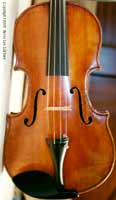
|
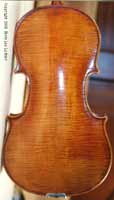
|

|
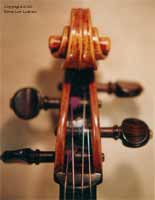
|

|
|
There are less than twenty Stradivari violas still in
existence.
|
The 1727 Cassavatti is one of the finest in overall condition
|
If you look closely, you can still see remains of ink on the
chamfer of the eye
|
An extremely wide pegbox makes changing strings easier but
also hinders playing in the half position
|
Scroll, bass side
|
|
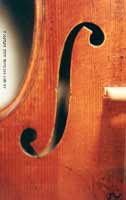
|
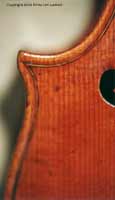
|
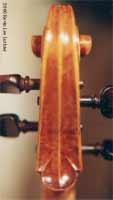
|
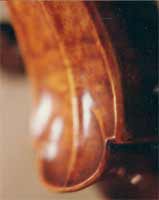
|
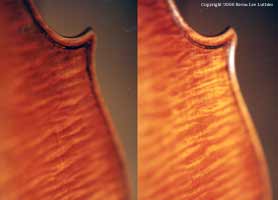
|
|
Not a typical shape
f-hole for Stradivari. (His sons also helped carve many of his
later instruments.)
|
This instrument was made when Antonio was 83
and showing the signs of old age. Also notice the cracks caused
by the poorly fitting purfling
|
A rare cello style scroll for this late of
viola, but Stradivari was not beyond "breaking the rules"
for a special customer
|
Another view showing the depth and contours of
the scroll heel
|
The dichroic
properties of Stradivari's varnish.
Left is in diffused light,
right is in direct light. (All master varnishes, new or old, will
do this.)
|
The
1701 "Servais" Cello
is presently housed at
"The Smithsonian" and considered by many to be the finest
cello ever made, though the point may be argued (especially by
average sized players) because of its "larger than standard"
size which makes it more difficult to play.
|
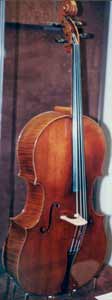
|
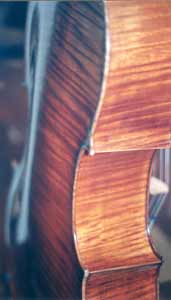
|
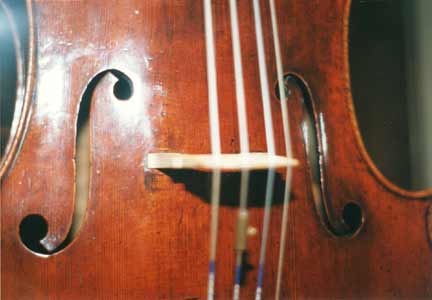
|

|
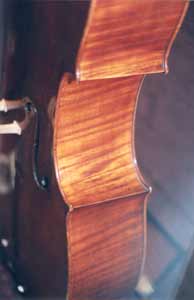
|
|
The "Servais" is a very large and
impressive instrument
|
A truly rare specimen with deep, widely flamed
maple
|
Even the finest cellos have "wolf notes,"
yet with a master instrument it is always "worth it."
|
Though over 300 years old, a typical and very
"clean" example of the Master's work.
|
One of the finest examples of Stradivari's wood
and varnish
|
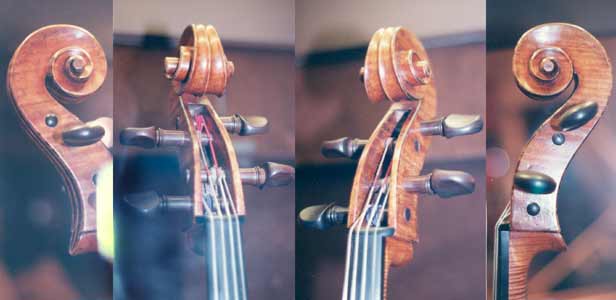
The
1709 "Greffuhle"
(One
of the finest inlaid Stradivaris.)
Pardon the quality of these
photographs. After playing the instrument for two days, I realized
that I hadn't taken any pictures until it was almost time to go.
It
really was a dream to play, but when I first picked up the Greffuhle,
the sound was a complete disappointment. But who can blame it; it had
a gut E-string, a steel A string, a Dominant D and a G-string that
was old and unrecognizable.
But after I adjusted the soundpost to
where it should be and replaced all the strings, it instantly came to
life and became the dream that it truly is.
You
can't judge any instrument's true value unless it is set up properly.
|

|
 
|
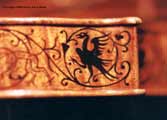
|
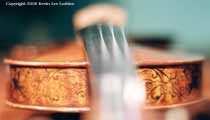
|

|
|
Stradivari made very few inlaid instruments and
always charged "dearly" for them even though some of
their voices were compromised by the thicker wood necessary for
the inlay work
|
The "Greffuhle" is a "Golden
Period" example and is the best sounding inlaid instrument I
have ever heard or played upon
How the light hits a master
instrument is everything. Right = the Greffuhle in subdued light.
|
All of Stradivari's inlay designs are his own
(original) and many of his templates still survive in private
collections and at the Stradivari museum in Cremona, Italy.
|
An angle that no ordinary pictures ever show.
|
The ribs are elaborately inlaid and were made
slightly thicker than his normal instruments
|
|

|

|

|

|

|
|
Closeup of the ivory diamonds and circles.
Compare with the "Rawlings" guitar below
|
Stradivari chose less flamed wood for his inlaid
scrolls so the patterns would stand out more
|
This violin has a full neck graft and a simple
fingerboard but the originals were believed to have been quite
elaborate
|
Stradivari used a mixture of inlaying techniques
on this instrument because he was always experimenting for a
better way
|
I believe he discovered it on the back of this
scroll and it is the same technique that I use on my own
instruments because it requires no compromise in sound quality
|
1700
"Rawlings" Guitar
(Again,
one of Stradivari's finest)
|

|

|

|
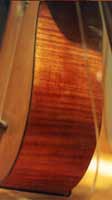
|
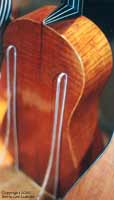
|
|
Guitars, like violins, violas and cellos are made
of spruce (for the belly) and maple (for the ribs, scroll and
back).
|
The inlay of ivory diamonds and circles are
almost identical to those used on Stradivari's inlaid
violins
(See Greffuhle above)
|
Though not considered to be one of the finest
guitar makers who ever lived, Stradivari used the finest
materials and did very well
|
A closeup of the varnish (one of his finest
examples)
|
Another closeup.
|
Etc.
|
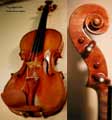
|
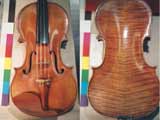
|
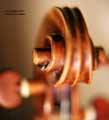
|
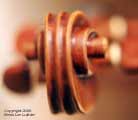
|
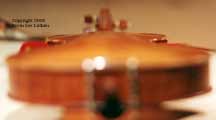
|
|
The "Ward" Stradivarius violin of 1700
|
The "Betts" Stradivarius violin of 1704
|
The "Betts" scroll
|
Another closeup
|
The "Betts" back arching
|
|

|

|

|

|
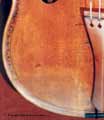
|
|
During Stradivari's "Golden" Period,
his craftsmanship was superb (compare this 1704 with the 1727
"Cassavatti" viola)
|
The "Axlerod" cello of 1688
|
1690 "Library of Congress" Viola
|
Stradivari was always experimenting, and this
viola of 1694 shows that decorations should not be merely painted
on a master instrument.
|
A master instrument needs to get better with age,
therefore all decorations must be "in" the wood in
order for them to last for the entire life of the instrument.
|
|

|
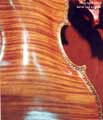
|

|

|
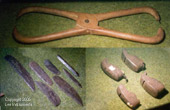
|
|
The 1699 "Castlebarco" violin
|
The back of the inlaid "Ole Bull"
violin of 1687
(Better looking than the Greffuhle yet it has
been re-graduated and is not as deep and rich sounding)
|
A closeup of Stradivari's diamonds and circles
from the Ole bull violin of 1687
(It is a beautiful
instrument)
|
The pride of the city of Cremona.
The "Cremonese" of 1715
|
Also see the webpage
"Stradivari's
Tools"
|
RETURN TO HOME
PAGE
Copyright 2006 Kevin Lee Luthier





















































